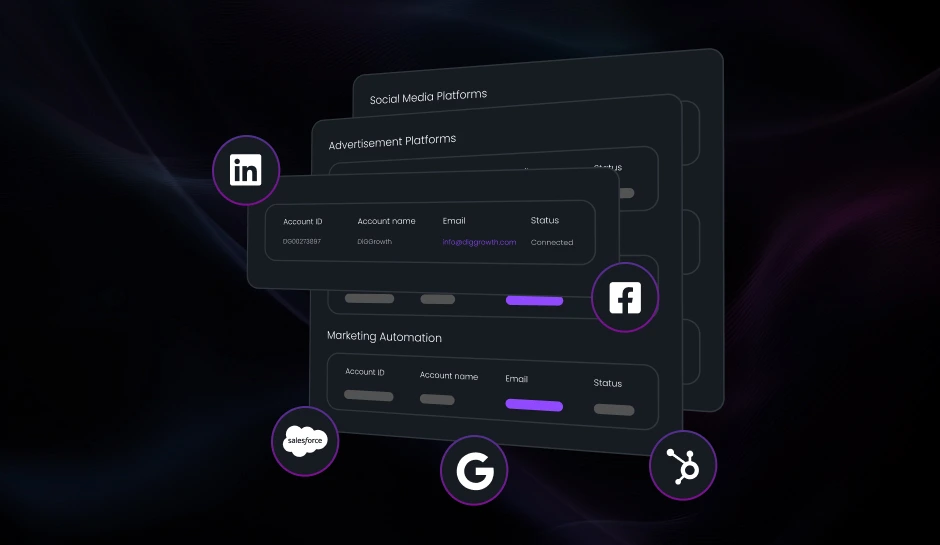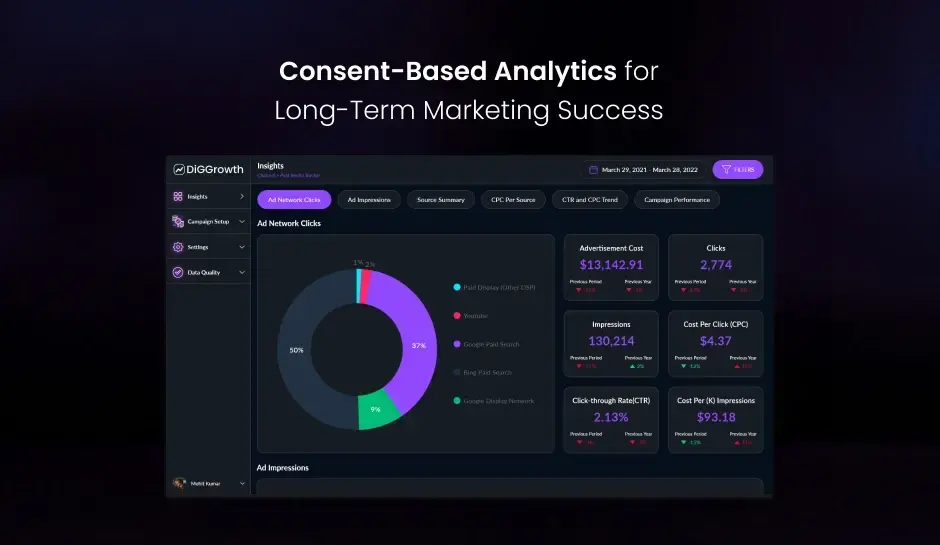
Why are Traditional Analytics & BI Tools Not Enough for B2B Marketers?
Traditional analytics & BI tools have outlived their utility. In this article, we dive into the limitations of these legacy tools and explore the smart and intelligent alternatives you should look at.
We live in an era where data has become the lifeblood of effective marketing strategies. Thanks to sophisticated technology and advanced analytics tools, today’s B2B marketers can access tons of data at will. However, if you’re still stuck using traditional analytics and BI tools, you may find it difficult to leverage these data-driven insights to their full potential.
Let’s look at the case of Google Analytics. Google is pulling the plug on Universal Analytics and replacing it with GA4. Despite having powerful features, traditional analytics and BI tools have outlived their utility.
Their lack of ability to handle growth in the volume and speed of data is a major limitation. Add to this, the fact that they force you into data silos and fail to offer real-time insights, it can hurt your marketing objectives. In this article, we dive into the limitations of these legacy tools and explore the smart and intelligent alternatives you should look at.
Understanding BI Tools
In today’s data-driven world, understanding and utilizing business intelligence (BI) tools is essential for any successful enterprise. These tools provide valuable insights and help make informed decisions by analyzing vast amounts of data. In this section, we will delve into the definition, components, key features, functionalities, and benefits of BI tools.
Definition and Components of a BI Tool
A BI tool, short for Business Intelligence tool, is a software application designed to analyze, present, and visualize complex data sets. It helps organizations extract actionable insights from their data, enabling them to make informed decisions. A typical BI tool consists of the following components:
Data Sources:
BI tools connect to various data sources, such as databases, spreadsheets, and cloud storage, to retrieve relevant data for analysis.
Data Warehouse:
This is where BI tools store and organize data in a structured manner, allowing for efficient and quick retrieval.
Data Modeling:
BI tools use data modeling techniques to transform raw data into meaningful information, making it easier to analyze and interpret.
Reporting and Visualization:
BI tools enable users to create reports, dashboards, and interactive visualizations, presenting data in a comprehensible way.
Key Features and Functionalities of BI Tools
BI tools offer a wide range of features and functionalities that empower organizations to explore, analyze, and interpret their data effectively. Here are some key features you can expect from a robust BI tool:
- Data Analysis:
- Interactive Dashboards
- Data Visualization
- Ad Hoc Reporting
- Collaboration and Sharing
BI tools provide advanced analytics capabilities, allowing users to perform complex calculations, apply statistical models, and uncover patterns or trends within their data.
Users can create intuitive dashboards that consolidate and display crucial metrics, enabling real-time monitoring and quick identification of performance issues.
BI tools offer various visualization options, such as charts, graphs, and maps, making it easier for users to comprehend and communicate complex data effectively.
With BI tools, users have the flexibility to generate customized reports on-demand, using parameters and filters to obtain specific insights.
BI tools enable users to collaborate on reports and dashboards, share insights, and distribute information securely with colleagues or stakeholders.
Benefits of Implementing BI Tools in an Enterprise
Implementing BI tools in an enterprise has numerous benefits that can drive growth, competitiveness, and efficiency. Some key advantages include:
- Improved Decision-Making
- Enhanced Operational Efficiency
- Increased Competitive Advantage
- Identifying Opportunities and Risks
- Improved Customer Satisfaction
BI tools provide timely and accurate insights, enabling informed decision-making based on data-driven evidence.
By streamlining and automating data analysis processes, BI tools free up time and resources, leading to increased efficiency and productivity.
Leveraging BI tools allows organizations to gain a better understanding of market trends, customer behavior, and competitor performance, providing a competitive edge.
BI tools help identify potential opportunities for growth or areas of risk, enabling proactive action and mitigation.
By analyzing customer data, BI tools assist in identifying customer preferences, addressing their needs, and enhancing overall satisfaction.
Why Are Traditional Analytics & BI Tools Not Enough?
To give credit where it is due – the legacy analytics and BI tools have served us well. But as we move towards a more data-driven world, the limitations of these tools can handicap your growth trajectory. Let us discuss the limitations of these tools for you to understand why sticking to them has and will show diminishing returns.
Incomplete Data Picture
Imagine a B2B marketer looking at sales figures during the pandemic’s peak and using this knowledge to develop a marketing strategy in 2023. It is bound to fail as the market dynamics have changed. Legacy marketing analytics and BI tools often provide a limited view of the data landscape. They rely heavily on historical data and fail to capture real-time insights.
The market dynamics have changed more in the last few years than in the past decade. As a B2B marketer, you need up-to-date information to make timely decisions and take proactive actions in such a scenario. Without a comprehensive and real-time view, you may miss critical opportunities or fail to respond to evolving market dynamics.
Lack of Actionability
One of the biggest challenges B2B marketers face is translating data insights into actionable strategies. You have beautiful charts, heatmaps, and graphs on traditional analytics tools. But can you draw actionable insights into today’s competitive market demands? Legacy tools may provide detailed reports and dashboards, but they fall short when enabling marketers to take timely action.
As we are witnessing exponential growth in the volume and velocity of data, these tools are failing. In today’s competitive environment, you need the ability to integrate analytics tools with marketing automation systems, CRM platforms, and other marketing technologies to execute data-driven campaigns and personalized customer experiences seamlessly.
Limited Cross-Channel Integration
Think of your B2B marketing campaign; first, you’d notice how they span multiple channels, such as email, social media, content marketing, and events. Having a complete picture of one channel and being in the dark about the other won’t let you achieve your desired goals. Legacy analytics tools were good in an era of web-only marketing campaigns. They struggle to integrate data from these channels, resulting in fragmented insights and a lack of holistic understanding.
As B2B marketing has changed in scale and intensity, you need tools to unify data from different sources, providing a comprehensive view of the customer journey and enabling them to optimize their marketing efforts across channels. If you stick to traditional analytics and BI tools, you won’t be able to run rewarding cross-platform campaigns.
Inability to Measure Full Attribution
Accurately measuring the impact of marketing campaigns is crucial for B2B marketers. If you don’t know which marketing campaigns work best for you and ones that aren’t finding traction with the users, you will fail to allocate budget and resources judiciously. For example, if social media generates maximum engagement, you must double up on social media marketing efforts.
Legacy analytics tools often fail to provide a complete attribution picture, particularly in complex multi-touchpoint buyer journeys. They may focus solely on last-click attribution or fail to account for the contribution of various marketing touchpoints along the customer’s path to purchase. You need advanced attribution models that can measure the effectiveness of each marketing touchpoint and allocate credit accordingly.
Lack of Predictive Capabilities
Last but not least, these tools are plagued by the lack of flexibility in data models. This results in their lack of predictive modeling capabilities. Becoming fixated on past data and not having an eye on the future can be your biggest undoing. In today’s fast-paced business environment, you must be proactive rather than reactive.
Legacy analytics tools often lack predictive capabilities, limiting marketers to historical analysis. By leveraging advanced predictive analytics and machine learning algorithms, marketers can uncover valuable insights, identify trends, and anticipate customer behavior, enabling them to make informed decisions and stay ahead of the competition.
Choosing the Right BI Tool for your Business
When it comes to selecting a Business Intelligence (BI) Tool for your business, making the right choice is crucial. A well-selected BI tool can empower your organization with valuable insights and assist in data-driven decision-making. However, with a myriad of options available in the market, it can be a daunting task to find the perfect fit for your specific needs.
Factors to consider when selecting a BI Tool
Before diving into the evaluation process, it’s important to identify the factors that hold significance for your business. Each organization has unique requirements and objectives, and these should guide your decision-making. Here are a few key factors to consider:
- The complexity of your data
- Scalability
- User-friendliness
- Integration
- Customization options
- Security
Determine the complexity of your data sources and whether the BI tool can effectively handle them.
Assess whether the tool can accommodate your current needs and future growth.
Consider the ease of use and intuitiveness of the tool, as it will impact user adoption and productivity.
Check if the BI tool seamlessly integrates with your existing systems and databases.
Evaluate the tool’s ability to adapt to your specific business requirements and allow for customization.
Ensure that the tool provides robust security features to protect sensitive business data.
Evaluating different BI Tools in the market
The next step is to evaluate the various BI tools available in the market. Take the time to research and compare different vendors, their offerings, and customer reviews. Consider the following factors during your evaluation:
- Features and functionalities:
- Pricing:
- Vendor reputation:
Make a list of the features that are essential to your business and compare how different tools meet those requirements.
Evaluate the pricing models and determine which tool provides the best value for money.
Customer support:
Look for a vendor that offers reliable and responsive customer support to address any issues or concerns.
Consider the reputation and track record of the vendor in the BI industry.
Matching your business requirements with the capabilities of BI Tools
Once you have a shortlist of potential BI tools, it’s essential to match their capabilities with your specific business requirements. Conduct thorough demos and trials to see how well each tool meets your criteria. Here are a few aspects to focus on during this process:
- Data visualization
- Data integration
- Report generation
Examine the tool’s capabilities in visualizing data in meaningful and insightful ways.
Dashboard customization: Assess the flexibility and ease of customizing dashboards to align with your business needs.
Verify if the tool can seamlessly integrate data from various sources and provide a comprehensive view.
Evaluate the tool’s reporting capabilities and the ease of generating reports.
By aligning your business requirements with the capabilities of different BI tools, you can narrow down your options and identify the most suitable tool for your organization.
Overcoming Common Challenges in Deploying BI Tools
Deploying BI tools in an organization can present some challenges, but with careful planning and execution, these challenges can be overcome:
- Lack of executive sponsorship
- Data silos and integration
- Data quality and integrity
- User resistance and adoption
- Complexity and scalability
Obtain executive buy-in and support to ensure the necessary resources, budget, and commitment are allocated to the implementation.
Address data silos by implementing robust integration processes that consolidate data from various sources. Break down silos by fostering collaboration and data sharing across departments.
Implement data cleansing and transformation processes to improve data quality and integrity. Regularly monitor data and establish data governance practices to maintain data accuracy.
Proactively address user resistance through effective change management strategies. Communicate the benefits of BI tools, provide comprehensive training, and offer ongoing support and assistance to ensure user adoption.
Select a BI tool that can scale as your organization grows and evolves. Consider factors such as ease of use and integration capabilities to simplify the implementation and ensure long-term scalability.
What To Look for In Modern Analytics & BI Tools
As you plan the switch to modern analytics and BI tools, it is important to choose one objectively. There is no dearth of analytics tools in the market, and hence you must look for features that matter instead of falling for fancy technical jargon. While these tools pack all the features traditional tools have, let us look at the must-have features that new-age analytics and BI tools should entail.
- Revenue-Focused Data
- Customer Journey Mapping
- ML-Driven Attribution
- Powerful Visualizations
B2B businesses must be revenue-focused. The tool you choose must accurately measure the impact on revenue from a marketing perspective. It should validate each marketing expenditure with an accurate revenue pipeline.
The tool must provide a complete picture of the customer’s buying journey. Since B2B businesses have a longer sales cycle, the tool should give you detailed insights into how customers interact with your brand, the channels they prefer, and the revenue path.
We touched upon the importance of attribution earlier. A modern analytics and BI tool must have an ML-driven attribution modeling feature. It will help you choose the right marketing channels.
No, we aren’t talking about pie charts and graphs anymore, but powerful visualizations that can help you make decisions based on real-time data and stand ahead of the competition.
And when you’re thinking modern analytics, think DiGGrowth! DiGGrowth is a modern AI-driven, no-code marketing analytics platform that gives CMOs, performance marketers, and the entire marketing team the superpower to solve data integrity, hygiene, and governance challenges. DiGGrowths’ analytics and attribution empower marketers to drive sales and revenue by deep-diving into the marketing metrics that make revenue forecasting easier and more accurate.
The Bottom Line
While once cutting-edge, legacy marketing analytics and BI tools are no longer sufficient in delivering the desired results. To stay competitive in the ever-evolving B2B landscape, you must harness the power of data-driven insights. Embrace modern analytics and BI tools to gain a real-time, holistic view of data and imbibe actionable decision-making culture.
Wish to Ace Marketing Analytics Like Modern Marketers Do? Let’s Talk!
If you are looking for a tool designed from the perspective of B2B marketers, DiGGrowth would fit the bill perfectly. To learn more, email us at info@diggrowwth.com.
Ready to get started?
Increase your marketing ROI by 30% with custom dashboards & reports that present a clear picture of marketing effectiveness
Start Free Trial
Experience Premium Marketing Analytics At Budget-Friendly Pricing.

Learn how you can accurately measure return on marketing investment.
Additional Resources
Integrating Data from Different Channels for a Holistic View of Your Marketing Performance
Who's your ideal customer? Where do they come...
Read full post postGet Your Channels to Play Nice: Integrated Data for Smarter Marketing
If you’re a savvy marketer, you’re living in...
Read full post postConsent-Based Analytics: Ensure Long-Term Marketing Success
As marketers, we want our customers to perceive...
Read full post post Subhadeep Bhattacharjee
Subhadeep Bhattacharjee 

